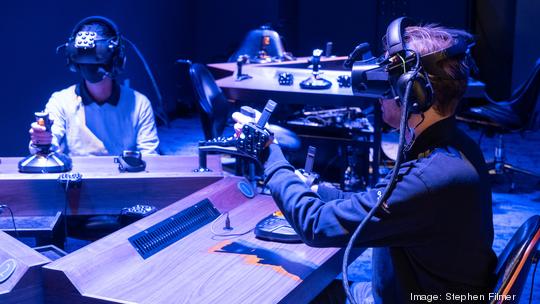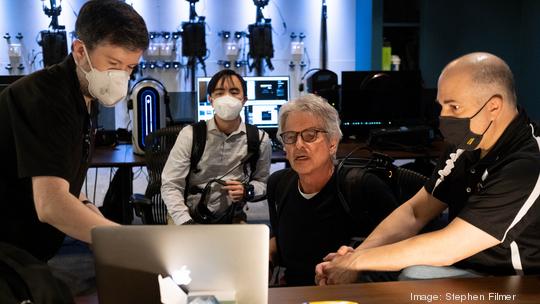
Wrapping your head around biology is becoming easier for students at Arizona State University — because learning basic biology is now an experience that can be literally wrapped around a student’s head.
Dreamscape Learn is a highly immersive virtual reality world ASU students can dive into as they don headsets and sensors and grasp a joystick. As they do, they are enveloped in a learning environment that surrounds the 360-degree space around them. The vivid landscapes and strange creatures they encounter have the verve and polish you would expect from Hollywood moviemakers. But the lessons and problem solving the students face when immersed in VR surroundings are grounded in the facts of hard science.

“One of the biggest presentation problems in higher education in the 21st century is student disengagement,” says Tom Fikes, director of research for ASU’s Action Lab. “If you’re in a space that allows you to be engaged, you’re more likely to stay, to persist, to retain. And in the case of a university, to graduate.”
The typical, traditional experience of learning basic college biology was born in another era, carrying with it limitations that can make it stale and uninspiring to the uninitiated.
“Canned, cookbook-type activities have outcomes that have been seen thousands of times before in thousands of other classrooms,” says ASU Professor Michael Angilletta, associate director of learning and innovation. “The student knows exactly what they’re supposed to find, and in many cases, they can simply search up the right answers online.”
Dreamscape Learn reimagines this teaching challenge with an assist from major league storytellers. DSL’s creative team is led by Walter Parkes, with big-screen credits on movies like “Minority Report,” “Men in Black,” and “Gladiator.”
It is a mindset that flips the paradigm for teaching and learning. Rather than pushing information out to the student to absorb, it pulls students into a learning environment that engages them directly. For example, one scenario challenges students to diagnose and solve threats to the reproductive cycles of creatures on an alien planet.
“You — the student — are the main character, the hero driving the story,” says Angilletta. “You’re discovering biological problems in this new world we call the Intergalactic Wildlife Sanctuary.”
Students are looking for creatures, or even whole ecosystems, in peril. They have to understand and use probes, make measurements and use reasoning skills to get answers.
“Dreamscape Learn is not a way you’ve learned before. It’s an experience that you are immersed in,” says Senior Research Assistant Alysha Ramirez Hall. “You are not just learning the material; you are part of the material. You’re part of the story, you’re part of the exploration.”
Powerful 3D visuals, narration and sound effects heighten student engagement in the lessons. Science fiction amplifies the science facts at each step in the coursework. None of this is happening inside a lecture hall or at a lab bench. Students are immersed in the biology questions because they’re immersed in the virtual environment, where their actions, movements, choices and decisions are all up to them.
Students are now enrolled in classes using Dreamscape Learn. Courses include BIO 181 and 182, which are classes required for pursuing higher-level biological science degree programs. A two-dimensional version of the same coursework and environments are in development to fit the needs of online students.
“I’m more of a hands-on learner, so this helped me retain more of the information,” says ASU biology student Michelle Valdez. “I felt like a true scientist when I was in there.”
Eyes, ears, and touch all stimulate a student’s brain in the Dreamscape Learn VR environments.
“This is something new, it’s not a textbook,” says ASU student Jace Reed. “It’s not a lab where we’re watching someone do it. We actually get to do it.”
“There’s a body of literature that already shows virtual reality experiences enhance retention,” says Angilletta. “This gives us the freedom to solve all sorts of problems using scientific principles in an imaginative way.”
Collaborations with other science schools within the university are already underway. It’s likely Dreamscape Learn will soon be integrated into more ASU curricula.
“We essentially have a portal that can take students anywhere to learn anything,’’ says Auryan Ratliff, ASU’s lead design evangelist for immersive and multimedia experiences. “And when you think about it that way, the better question might be what won’t Dreamscape Learn look like in the future? Because anything is really possible.”
Learn more about Dreamscape Learn and what it’s like to go inside it: Devils in the Details.
Arizona State University serves more than 70,000 students across five campuses in the Phoenix Metropolitan area and is ranked by U.S. News & World Report as the country's most innovative school. Since 2002, the university's mission has been to create a new model for higher education in the United States that meets the challenges of the 21st century.


